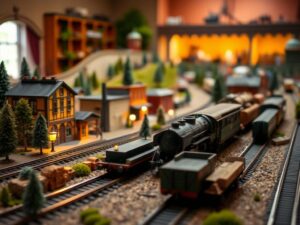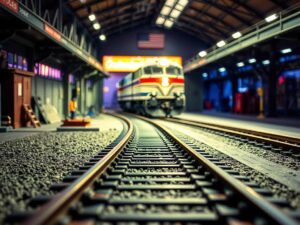How to Prevent Derailments in Your HO Scale Layout
How to Prevent Derailments in Your HO Scale Layout
Keepin’ ‘Em on the Rails: A Deep Dive into Preventing Derailments in Your HO Scale Layout
Hey, fellow railfans! There’s nothing quite like the satisfaction of watching a smoothly flowing train procession around your meticulously crafted HO scale layout. The whirring of wheels, the soft chugging of engines, and the visual symphony of rolling stock â it’s pure joy. But let’s face it, every seasoned hobbyist knows the dread that comes with that click-clack, scraping sound that signals a derailment.
Trust me, we’ve all been there. It’s frustrating to watch your perfectly posed train come undone. The good news? You can take proactive steps to minimize these track troubles and keep your rolling stock firmly planted on the rails.
Understanding the Enemy: Why Do Derailments Happen in HO Scale
Before we delve into solutions, it’s crucial to understand the common culprits behind those pesky derailments. In the world of HO scale, even the smallest imperfection can cause chaos:
- Track Misalignment: The bane of many modelers, misaligned tracks can throw trains off course with a subtle shift in elevation or curvature.
-
Uneven Track Beds: Whether caused by poorly packed ballast, loose substructure, or inadequate leveling, uneven track beds create those tiny hills and valleys that are derailment waiting to happen.
-
Loose Fasteners: Those small clips and screws holding your tracks together? They need to be tight! Even a slightly loosened fastener can cause misalignment and instability.
-
Track Gauge Issues: This refers to the spacing between the rails, and even minor discrepancies can force wheels off the proper path.
-
Sharp Turn Radii: The tighter the turn, the greater the strain on the track and the wheels. Trains may struggle to navigate exceptionally sharp curves without derailing, especially if they are carrying heavy loads.
- Debris Accumulation: It happens to all of us: leaves, dust, or even bits of rolling stock can get stuck between the rails and create a barrier that sends your trains tumbling.
Preventing the Nightmare: Tips for Keeping Your HO Scale Trains on Track
Ready to transform your layout from a derailment-prone disaster zone into a smoothly flowing model railway haven? Let’s break down the steps to achieve track mastery:
1. Mastering the Art of Leveling:
Your tracks should be absolutely level. Use a spirit level to check every section before laying it down and make adjustments as needed by raising or lowering the support structures underneath your layout.
2. Solid Foundations are Key: Invest in a well-built substructure that provides a stable foundation for your track work. Consider using foam insulation board, plywood, or even sturdy plastic containers. Remember, a firm base ensures your tracks remain level and securely fastened.
3. Embrace the Power of Gauging Tools:
Accuracy is paramount! Use a gauge tool to double-check the spacing between your rails as you lay them down. A tiny variation in gauge can lead to significant derailments, especially on curved sections.
4. Track Fastening for Success: Secure each piece of track firmly to your substructure using proper screws and clamps. Those loose connections create movement that ultimately leads to derailments. Regularly inspect your fastening system and tighten anything that feels loose.
5. Embrace the Gradual Curve:
Avoid overly sharp turns, as they put significant stress on the wheels and track alignment. When designing your layout, opt for gradual curves with wide radii. The more gently a train transitions through a curve, the less chance of derailing.
6. Cleaning is Queen (or King!)
Regularly clean your trackwork with a cotton swab or soft cloth to remove any debris, dust, or oils that can cause friction and lead to derailments. Consider using a specialized track cleaning car on your layout for even better results.
7. Testing, Testing:
Never skip the testing phase! Once your track is laid down, test your trains thoroughly at various speeds to identify any potential issues. Watch closely for signs of wheel slipping, track bouncing, or anything that seems out of place. Remember, it’s much easier to fix problems before they cause a full-blown derailment!
8. Rolling Stock Matters: Make sure your locomotives and cars are in good condition, with properly functioning wheels and bearings. Wheels should be clean and lubricated to minimize friction and allow for smooth operation.
Moving Beyond the Basics: Advanced Derailment Prevention Strategies
So, you’ve got the fundamentals down, but still want to take your HO scale track management to the next level? Consider these advanced tips:
1. Magnetic Track Sensors: These clever devices can detect when a train has left its designated path and send a signal to automatically stop it or trigger an alarm.
2. Power Routing Systems: Implement a system for routing electrical power through different sections of your track. This allows you to isolate sections that may be malfunctioning and helps prevent entire trains from derailing due to isolated power failures.
3. Digital Command Control (DCC): With DCC, each locomotive can receive individualized control signals, enabling smoother starting, stopping, and operation through curves.
4. Virtual Prototyping Software: Use virtual design software to simulate your layout before building it. You can test different track configurations and curve radii to minimize the potential for derailments right from the start.
A World Without Derailments (Almost!): Conclusion
Derailments are an unfortunate reality in model railroading, but with careful planning, diligent track maintenance, and these prevention strategies, you can significantly reduce their frequency. Remember, the journey is about creating a visually stunning and operationally rewarding layout. Embrace the learning process, share your experiences with fellow hobbyists, and always enjoy the ride!
Keep those wheels rolling smoothly,
[Your Name]




